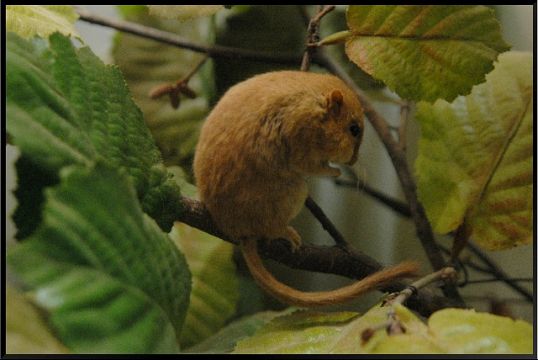| Verbreitungsgebiet / Lebensraum |
|---|
Distribution:The area od distribution reaches from Central Europe up to East Europe. Their habitats are not Spain, Portugal,the British Isles and Scandinavia. The habitat of the Common Dormouse is undoubtedly the hazel – bush. It lives further in blackberry hedges and decidous forests, seldom timber forests with beeches or coniferous forests. The Common Dormouse are active during night. During autumn,if the temperatures fall below 15 degree Celsius,begins the hibernation. For that it makes its way into ground holes,which covered by leaves fallen down. Its body temperature sinks sarce up to zero. Normally, the hibernation ends at beginning May. It may be active in April according to temperature during spring. It storage fat, to get without food in this time. |
| Nahrung |
|---|
Food:Most important component ofthe food are fruit of hazel -bushes. It eat further larvas and eggs of birds.Berries are just food as different fruit. Because the Common Dormouse has no caecum,being unique for rodents, is the food poor in respect of cellulose. |
| Fortpflanzung |
|---|
Reproduction:During the mating season these rodents build a spherical nest having a diameter of up to twelve centimetres. Nests consisting of grasses, leaves and mosses are built into the hazel -bushes in a high of approx. to metres. They use insome cases leaved nest boxes of birds,to bring their young into the world. The female throws twice the year between two and five youngs. These stay in the the nest together with the mother during six up to seven weeks,before they become independent. The live expectancy lies at approx. four years. |
| Systematik | ||||||||||||||||||||||||||
|---|---|---|---|---|---|---|---|---|---|---|---|---|---|---|---|---|---|---|---|---|---|---|---|---|---|---|
|
||||||||||||||||||||||||||
| Literatur |
|---|
| Galerie |
|---|
| Steckbrief |
|---|
Datum: Donnerstag, 20 Februar 2014 17:52
|
| Informationen |
|---|
|
Diese E-Mail-Adresse ist vor Spambots geschützt! Zur Anzeige muss JavaScript eingeschaltet sein! |



